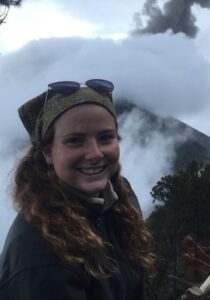 Biography
Biography
I am a PGR based in Leeds, at the University of Leeds working with Dr Ivan Savov, investigating the volatiles sources of volcanic systems across the Kamchatka volcanic arc, Russia. Collaborating with Dr Alex Iveson at Durham and Dr Tatiana Churikova in Moscow.
I previously completed my Masters focusing in Volcanology at University College London where I carried out the geochemical analysis (FTIR, SEM/EDs & Raman spectroscopy) of olivine hosted melt incision to explore the degassing of active basaltic systems in the CAVAs.
My interest lies in understanding volcanic processes through the study of magmatic volatiles and their related inputs and outputs. I primarily study the geochemical properties of erupted material at volcanic settings to gain a better understanding of the physical and chemical properties of the underlying mantle, interaction with crust and the associated magmatic systems.
Qualifications
2016-2020 MSci in Earth Science (international programme UCSB) from University College London
Research Interests
- Volcanology and magmatic volatiles
- Volcanic unrest and monitoring/hazards.
- Geochemistry & Petrology
- Magma storage & transportation processes
Teaching interests
Volcanic processes, volcanic mapping, isotope geochemistry and igneous petrology.
Project Title
Diverse sources of volatile release across volcanic arcs: Insights from Kozelsky and Khangar volcanoes, Kamchatka
Supervisors
Dr Ivan Savov (University of Leeds)
Dr Dan Morgan (University of Leeds)
Funding
Panorama NERC DTP, 2021
Project outline
The Kamchatka peninsula is one of the most volcanically active regions on Earth and is a natural laboratory to study the fate of subducted old (cold) oceanic crust and the interplay of magmatism. Uniquely the volcanoes of this arc erupt in several, rather than one, broad volcanic lineaments, possibly sampling magmatic fluid and melt sources in the forearc, beneath the main volcanic front and also from the behind-the-arc region. Geophysical and geochemical results show that the Kamchatka volcanoes sample fluids derived from slab depths from as little as 50km to as deep as 350 km. While the majority of arc volcanoes (here and elsewhere in other arcs) result from flux melting of depleted subarc mantle wedge source, the geochemistry of the arc volcanic rocks (incl. 10Be, U- series, B & Li isotopes, B/Be, B/Nb and Sr/Y ratios, among others) also shows, sometimes significant elemental and isotopic inputs from subducted slabs.
This project aims to address the volatiles sources and interaction across the Kamchatka arc by examining the geochemistry and petrology of volcanic products erupted along a SE-NW oriented depth transect across the Eastern Volcanic Arc Front and deep into the rear arc (Sredinny Ridge) region. In previous fieldwork campaigns we have extensively sampled Avachinsky and Bakening volcanoes that are ideally situated in the middle of cross-arc transect and represent depths to the top of the slab of 120 to 200 km., respectively. Here we will aim to conduct fieldwork and sample and study the volatile and fluid mobile element systematics in additional volcanoes from the same (arc front orthogonal) transect.
Geochemical and petrological studiesallow for the quantification of these magmatic processes and insight into which changes drive and control them. The olivine- and pyroxene- bearing mafic samples (preferably scoria) we collect will be used to extract melt inclusions (MI) from the mafic minerals (ol, px, hbl). The new MI will be adding, for the first time, an exceptional high resolution look at the petrochemical variations across active volcanic arc. Moreover, we will uniquely have a chance to examine compositional changes of slab derived fluxes with increasing depth-to-slab.
